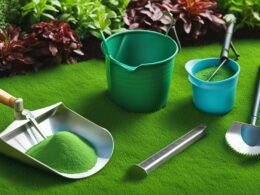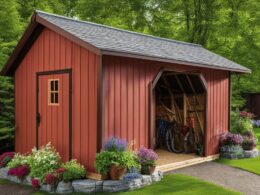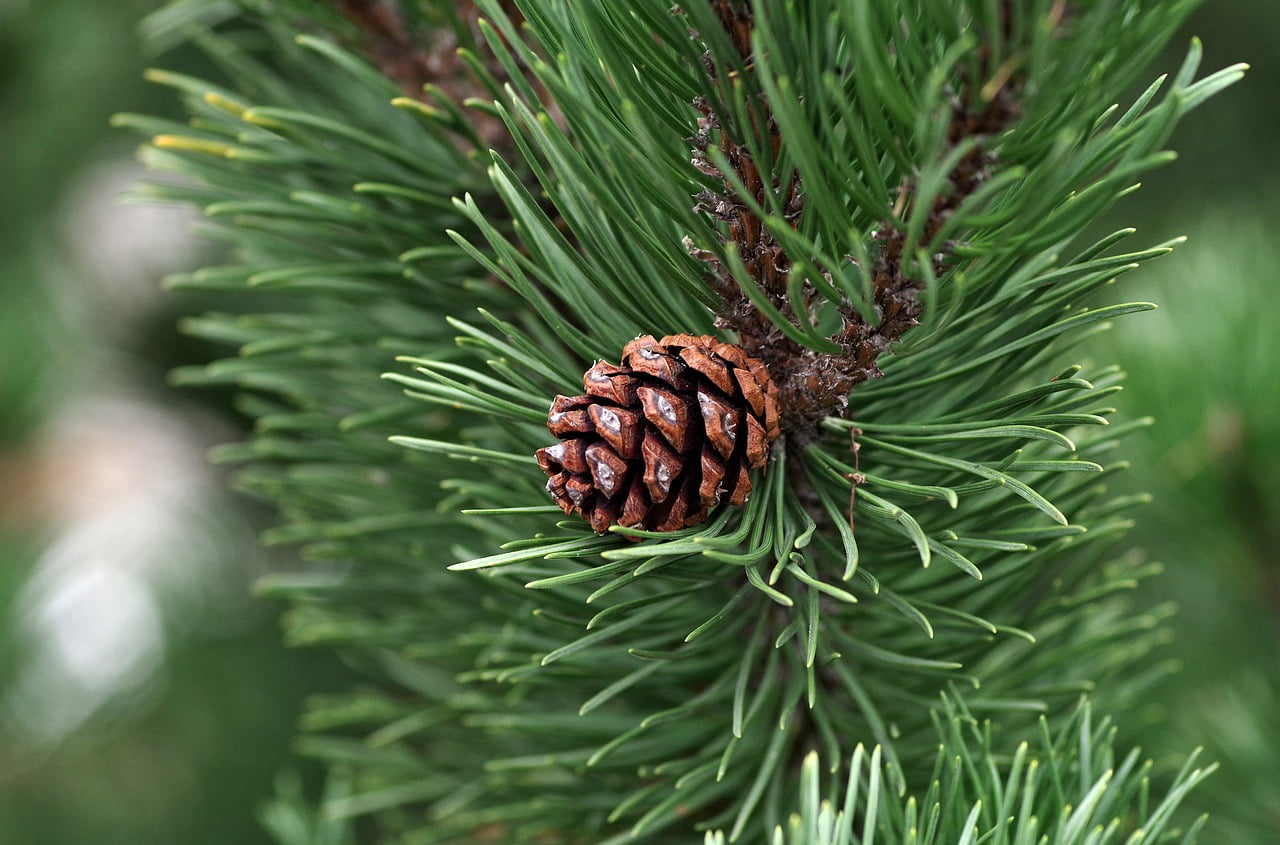Picking out plants for your garden can be exciting, but understanding the differences between annuals, perennials, and biennials is essential. Annuals live for one year, biennials live for two years, and perennials live for more than two years. Planting a combination of these three types of plants is key to long-term garden success. In this article, we will explore the characteristics and care requirements of each type.
Key Takeaways:
- Annuals live for one year, biennials for two years, and perennials for more than two years.
- A combination of annuals, perennials, and biennials ensures a diverse and vibrant garden.
- Annuals provide a burst of color, perennials offer year after year beauty, and biennials have a unique two-year life cycle.
- Proper plant care, including watering, fertilization, and pruning, is essential for the health and vitality of all plant types.
- Watering schedules should be adjusted based on the specific needs of annuals, perennials, and biennials.
Annuals: Burst of Color
Annuals are the vibrant stars of any garden, providing a burst of color and beauty throughout the growing season. These plants complete their life cycle within a single year, starting from germination in spring to blooming in summer, and eventually releasing seeds before the onset of fall. Contrary to popular belief, annuals are not one-hit wonders, as many of them produce thousands of seeds for future generations before they die.
There are three categories of annuals: tender, hardy, and half-hardy. Tender annuals thrive in warm climates and bring joy to flower shows and summertime gardens. However, they cannot withstand the chilly touch of the first frost, making them a seasonal delight. On the other hand, hardy annuals are resilient and can thrive even in late fall and winter, adding vibrant splashes of color to a subdued landscape. Finally, half-hardy annuals fall somewhere in between, as they can withstand cool temperatures to provide stunning foliage and blooms well into the autumn months.
Annuals come in a wide range of plant varieties, each with its own unique characteristics and growing requirements. Popular annual varieties include marigolds, geraniums, basil, zinnias, and petunias. These plants are known for their vigorous growth, quick germination, and abundant blooming, making them a favorite choice for gardeners seeking immediate visual impact. Whether you’re planting annuals from seedlings or planting seeds directly into the soil, they are sure to bring life and color to your garden.
Let the vibrant colors of annuals transform your garden into a stunning spectacle. With their short life cycle and endless blooming potential, these plants offer dynamic beauty year after year. Explore the vast array of annual plant varieties available and introduce them to your garden for a burst of color and joy that will leave you enamored.
Perennials: Year after Year Beauty
Perennials are the backbone of any garden, offering year after year of beauty and charm. Unlike their more short-lived counterparts, perennials live for three or more years, providing a sense of permanence to your outdoor space. Understanding the growth cycle and characteristics of perennials will help you select the right plants for your garden.
Perennials go through a growth cycle that spans multiple years. During the first two years, perennials focus on establishing a strong root system rather than producing blossoms. This investment in root development ensures the plant’s longevity and resilience, setting the stage for a stunning display of foliage and blossoms in the coming years.
There are two main types of perennials: woody and herbaceous. Woody perennials, such as trees and shrubs, have sturdy, brown stems that provide structure and permanence to your garden. These plants do not experience seasonal dieback and remain green and vibrant throughout the year. Herbaceous perennials, on the other hand, have soft, green stems that die back in the fall and winter, only to emerge anew in the spring. This cycle of growth and dormancy adds rhythm and variation to your garden landscape.
Perennials come in a wide range of plant types, each with its own unique characteristics. Some perennials are considered tender, meaning they thrive in warm climates but may not survive frost in colder regions. Hardy perennials, on the other hand, can withstand freezing conditions and even snow, making them suitable for harsher climates. Finally, half-hardy perennials fall somewhere in between, with moderate cold tolerance.
When it comes to selecting specific perennial varieties for your garden, the options are endless. Popular choices include lavender, rosemary, peony, astilbe, and daylily, each adding their own distinctive charm and beauty to your outdoor oasis.
With their long lifespan, diverse growth patterns, and exquisite blossoms, perennials are a must-have for any garden enthusiast. Whether you opt for the sturdy woody perennials or the resilient herbaceous varieties, these plants will reward you year after year with their enduring beauty.
Biennials: Two-Year Wonders
Biennials, as the name suggests, have a unique two-year life cycle. In the first year, these plants focus on establishing their roots and developing foliage. It is during this initial stage that biennials lay the foundation for their eventual flowering and seed production in the second year. This multi-year life cycle sets biennials apart from both annuals and perennials.
While some biennials may not survive the winter after their first year, others can live longer or even complete their entire life cycle within a single growing season. The timing of flowering and seed production varies depending on the specific biennial plant.
Common examples of biennial plants include beets, carrots, kale, foxgloves, and hollyhocks. These diverse biennials showcase the range of growth forms and uses within this plant group.
Biennials often exhibit greater cold hardiness compared to annuals. Their ability to withstand colder temperatures makes them suitable for regions with harsh winters. Additionally, their longer life cycle allows for early spring planting, providing ample time for root establishment before the arrival of summer heat.
Understanding the life cycle, optimal planting times, and cold hardiness of biennials is crucial in incorporating these fascinating plants into your garden. Let’s explore some more plant care tips to ensure the success of your biennials and other garden plants.
Plant Care Tips
Proper care is essential for the health and vibrancy of your garden plants. By following these plant care tips, you can ensure that your plants thrive and flourish.
Watering
Watering is an vital component of plant care. To promote strong root growth, it’s important to water your plants deeply. This allows the water to reach the roots and encourages them to grow deeper into the soil. Consider using a soaker hose or drip irrigation system for efficient and targeted watering.
Fertilization
Fertilizing your plants is crucial for providing them with essential nutrients. When it comes to annual seedlings, you can promote strong growth by using a complete N-P-K fertilizer. This type of fertilizer contains nitrogen, phosphorus, and potassium, which are essential for healthy plant development.
Mulching
Applying organic mulch around your plants can offer numerous benefits. Mulch helps protect the plant roots from extreme temperatures, retains moisture in the soil, and suppresses weeds. Consider using organic materials such as wood chips, straw, or compost as mulch for your garden.
Weeding
Weeding regularly is an important part of plant care. Weeds can compete with your plants for nutrients and space, hindering their growth. Take time to remove weeds from your garden beds to give your plants the best chance to thrive.
Deadheading
Deadheading is the process of removing spent flowers from your plants. This practice not only keeps your garden looking tidy but also encourages new growth and prolongs the flowering period. Allow some flowers to go to seed, as they will naturally reseed and provide new plants in the future.
Pruning
Pruning is essential for maintaining the health and shape of your plants. Regular pruning helps remove diseased or damaged branches, improves air circulation, and promotes proper growth. Be sure to use clean pruning tools and follow proper pruning techniques for each plant variety.
Staking
Tall annuals may require staking for support. Staking ensures that the plants remain upright and prevents them from bending or breaking under their own weight. Use stakes or trellises to provide support to your taller plants and secure them as needed.
By implementing these plant care practices, including proper watering, fertilization, mulching, weeding, deadheading, pruning, and staking, you can create an environment where your plants thrive and flourish.
Watering Schedules
Watering schedules play a crucial role in the health and growth of your plants. The amount and frequency of watering can vary depending on the plant type. To ensure strong root growth and prevent plants from drying out and dying, it is important to water deeply.
Deep watering encourages plants to develop a robust root system that can access water and nutrients from deep within the soil. Shallow waterings, on the other hand, can lead to shallow roots that are more susceptible to drying out.
One effective method of delivering water directly to the plant roots is by using a soaker hose or a drip irrigation system. These systems help minimize water wastage through evaporation and ensure that the water reaches the roots where it is most needed.
Each plant type has its own water requirements, and it is important to understand these needs to provide the appropriate amount of water for optimal growth. Some plants, like succulents, have low water needs and prefer drier soil, while others, such as tropical plants, require more frequent watering.
By understanding the specific water needs of different plant types, such as annuals, perennials, and biennials, you can tailor your watering schedule accordingly. This will help ensure that your plants receive the right amount of water to thrive and flourish.
Remember to monitor your plants and make adjustments to your watering schedule as needed. Factors such as weather conditions, soil type, and the stage of growth of your plants can also influence their water requirements.
With a well-planned watering schedule and proper attention to the water needs of your plants, you can contribute to their overall health and vitality, promoting lush foliage, vibrant blooms, and a thriving garden.
Conclusion
In conclusion, understanding the differences between annuals, perennials, and biennials is crucial for successful gardening. By incorporating all three types of plants in your garden, you can enjoy the immediate burst of color from annuals, the long-lasting beauty of perennials, and the unique life cycle of biennials.
Proper plant care, including watering, fertilization, mulching, and pruning, is vital for the health and vitality of all plant types. By following these guidelines, you can create a vibrant and thriving garden. Remember to water your plants deeply to encourage strong root growth and consider using a soaker hose or drip irrigation system for efficient watering. Fertilize your annuals with a complete N-P-K fertilizer to promote strong growth, and apply organic mulch to protect roots and retain moisture. Regular weeding, deadheading, and pruning will keep your garden beds healthy, and staking tall annuals will provide the necessary support.
By incorporating the knowledge of plant types, such as annuals, perennials, and biennials, and implementing proper plant care techniques, you can maintain a beautiful and thriving garden that brings joy and beauty year after year. Happy gardening!
How Can Annuals, Perennials, and Biennials be Utilized in a Shade Structure Garden?
Annuals, perennials, and biennials can all thrive in shade structures for outdoors gardens. Annuals like impatiens and coleus provide bursts of color, while perennials such as hostas and ferns offer reliable greenery. Biennials like foxgloves add vertical interest. These plants can be strategically placed to create a beautiful and diverse shaded garden.
FAQ
What are annuals?
Annuals are plants that complete their life cycle in one growing season. They germinate in the spring, bloom in the summer, and release seeds before dying in the fall.
What are perennials?
Perennials are plants that live for three or more years. They come in two categories: woody and herbaceous. Woody perennials have tough brown stems and do not experience seasonal dieback, while herbaceous perennials have soft, green stems and die back in fall and winter.
What are biennials?
Biennials have a two-year life cycle. In the first year, they establish roots and foliage, and in the second year, they flower, produce seeds, and die back.
What are the categories of annuals?
Annuals are categorized as tender, hardy, or half-hardy. Tender annuals thrive in warm climates and die when the first frost arrives. Hardy annuals can withstand cold weather and remain colorful in late fall and winter. Half-hardy annuals are less cold-resistant than hardy ones but can tolerate cool temperatures and provide fall foliage.
What are the categories of perennials?
Perennials are classified as woody or herbaceous and can be categorized as tender, hardy, or half-hardy depending on their cold resistance. Tender perennials thrive in warm climates but may not survive frost in colder regions. Hardy perennials can withstand freezing conditions, while half-hardy perennials are not as cold-tolerant.
What are some examples of popular annuals?
Popular annual varieties include marigold, geranium, basil, zinnia, and petunia.
What are some examples of popular perennials?
Popular perennial varieties include lavender, rosemary, peony, astilbe, and daylily.
What are some examples of common biennials?
Common biennial plants include beets, carrots, kale, foxgloves, and hollyhocks.
What care practices are important for plant health?
Important care practices include watering deeply, fertilizing seedlings, applying organic mulch, regular weeding, deadheading spent flowers, pruning, and staking tall annuals for support.
How should I water my garden plants?
Water deeply to encourage strong root growth and use a soaker hose or drip irrigation system for efficient watering.
What are the watering schedules for different plant types?
Watering schedules vary depending on the plant type. Shallow waterings can cause plants to dry out and die, so it is important to water deeply. Each plant type has different water requirements, and it is important to understand the needs of annuals, perennials, and biennials to provide the appropriate amount of water.











